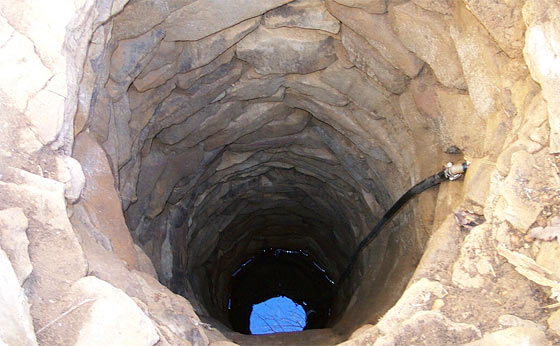Ground Water Source: A Dug Well
A dug well is a simply a hole in the ground dug by shovel or backhoe.
Years ago, a ‘dug well’ was used for many a household’s water supply, but most are “relics” of older homes, dug before drilling equipment was readily available or when drilling was considered too expensive.
In a SHTF world though, knowing the basics of a ‘dug well’ (and the fact that it is possible) is good knowledge. If you don’t have access to drilling equipment, and your surface groundwater table isn’t too deep, it may be possible to dig a dug well to supply some or all of your water needs for survival…
Simply put, a dug well is formed when you dig (excavate) below the groundwater table until incoming water overtakes the digger’s bailing rate.
Afterward, the well is lined (cased) with something like stones, brick, tile, or other material to prevent collapse of the side walls and to help prevent contamination entering this way.
To prevent contamination from above, the well is then typically covered with a cap – made of wood, stone, or concrete, etc.
Since it is so difficult to dig beneath the ground water table, a typical dug well is not very deep. One problem is that being so shallow, a dug well has a higher risk of becoming contaminated. To minimize the likelihood of contamination, your dug well should have certain features like sealed side walls and a cap.
The land surface around the well should be mounded so that surface water runs away from the well and is not allowed to pond around the outside of the wellhead.
Land activities around a dug well can also contaminate it, so be sure and protect the area around the well – at least 50 feet.
Another problem relating to the shallowness of a dug well is that it may go dry during a drought when the ground water table drops.
If you have a dug well, be sure and test the water – as you should periodically with any well, but especially with a dug well which is more susceptible to surface contamination.
Don’t forget about the necessity to clarify and purify the water before drinking.
The shallow groundwater table may vary widely – even in short distances. In some regions there is no such thing as shallow ground water, while in other areas the water may be inches below the surface.
The concept of a dug well is simple, but from a preparedness standpoint it is good simple knowledge. Fresh water for drinking is a precious resource and necessary for survival, second only to the air we breathe.
A few interesting resources:
USGS online Groundwater Atlas of the United States
USGS Active Groundwater Level Network (map)
Google Earth Groundwater Stations Map

